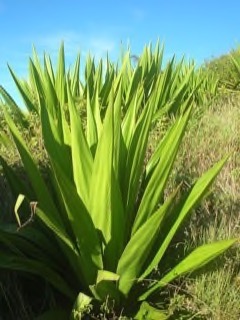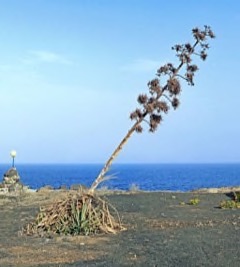 |
|
Forest & Kim Starr www.starrenvironmental.com |
 |
| wikimedia.org H.Zell |
Translate this page:
Summary
Physical Characteristics

 Furcraea foetida is an evergreen Perennial growing to 2 m (6ft) by 2 m (6ft) at a fast rate.
Furcraea foetida is an evergreen Perennial growing to 2 m (6ft) by 2 m (6ft) at a fast rate.
See above for USDA hardiness. It is hardy to UK zone 10. The flowers are pollinated by Birds, Bees.
It is noted for attracting wildlife.
Suitable for: light (sandy) and medium (loamy) soils and prefers well-drained soil. Suitable pH: mildly acid, neutral and basic (mildly alkaline) soils. It can grow in semi-shade (light woodland) or no shade. It prefers dry or moist soil and can tolerate drought.
UK Hardiness Map
US Hardiness Map
Synonyms
Agave bulbosa K.Koch Agave commelyni Salm-Dyck Agave foetida L. Agave gigantea (Vent.) D.Dietr. Agave madagascariensis (Haw.) Salm-Dyck Aloe foetida (L.) Crantz Fourcroya gigantea (Vent.) Hook. Funium piliferum Willemet Furcraea atroviridis Jacobi & Goeff. Furcraea barillettii Jacobi Furcraea commelyni (Salm-Dyck) Kunth Furcraea gigantea Vent. Furcraea madagascariensis Haw. Furcraea viridis Hemsl. Furcraea watsoniana Sander
Plant Habitats
Edible Uses
References More on Edible Uses
Medicinal Uses
Plants For A Future can not take any responsibility for any adverse effects from the use of plants. Always seek advice from a professional before using a plant medicinally.
The root has been used as blood purifying remedy[317 ]. An infusion with sweet oil is drunk as a treatment for syphilis[348 ]. The root is mixed with gin and used as a treatment for back pain[348 ]. The leaves are febrifuge[348 ]. They are used in a preparation with molasses or honey to treat children's obstinate colds[348 ].
References More on Medicinal Uses
The Bookshop: Edible Plant Books
Our Latest books on Perennial Plants For Food Forests and Permaculture Gardens in paperback or digital formats.

Edible Tropical Plants
Food Forest Plants for Hotter Conditions: 250+ Plants For Tropical Food Forests & Permaculture Gardens.
More

Edible Temperate Plants
Plants for Your Food Forest: 500 Plants for Temperate Food Forests & Permaculture Gardens.
More

More Books
PFAF have eight books available in paperback and digital formats. Browse the shop for more information.
Shop Now
Other Uses
Agroforestry Uses: Used as a hedge plant in desert gardens[317 , 418 ]. Other Uses: A strong, good quality fibre is obtained from the leaves[46 , 317 ]. It is thinner and softer than sisal[317 ]. The fibre is usable for ropes and sacks[317 ]. The long, soft fibre is used alone or with other fibres in twine, sacks, hammocks, and other products[418 ]. It breaks down in salt water but withstands fresh water[418 ]. The macerated young leaves are used as a hair shampoo and a soap[348 ].
Special Uses
Carbon Farming
References More on Other Uses
Cultivation details
Agroforestry Services: Living fence Industrial Crop: Fiber Management: Standard Regional Crop
A plant of the tropics. It grows best in areas where annual daytime temperatures are within the range 23 - 30?c, but can tolerate 16 - 34?c[418 ]. It prefers a mean annual rainfall in the range 1,000 - 2,100mm, but tolerates 700 - 2,500mm[418 ]. Requires a well-drained, medium to light soil and a sunny position[200 , 418 ]. Prefers a pH in the range 6 - 7, tolerating 5.5 - 8[418 ]. Very drought tolerant, the plant is able to withstand a dry season of 8 months[418 ]. The plant has escaped from cultivation in some areas - in New Caledonia it has become a noxious weed[317 ]. The plants inflorescences produce bulblets in large quantities; these disperse naturally and form dense impenetrable stands which exclude native vegetation[413 ]. The plant takes 3 - 4 years before its first harvest, and thereafter it can be harvested every 2 - 3 years[418 ]. It has a total life span of 7 - 10 years[418 ]. Yields of between 60 - 90 tonnes/ha of green leaf can be obtained every other year, which compares to 2 - 3 tonnes of dry fibre[418 ]. Plants are monocarpic - they live for a number of years without flowering, then put all their energy into flowering and die afterwards[200 ].
Carbon Farming
-
Agroforestry Services: Living fence
Simply managed rows of shrubs and trees.
-
Industrial Crop: Fiber
Clothing, rugs, sheets, blankets etc. Currently, almost none of our fiber are produced from perennial crops but could be!
-
Management: Standard
Plants grow to their standard height. Harvest fruit, seeds, or other products. Non-Destructive management systems.
-
Regional Crop
These crops have been domesticated and cultivated regionally but have not been adopted elsewhere and are typically not traded globally, Examples in this broad category include perennial cottons and many nuts and staple fruits.
References Carbon Farming Information and Carbon Sequestration Information
Temperature Converter
Type a value in the Celsius field to convert the value to Fahrenheit:
Fahrenheit:
The PFAF Bookshop
Plants For A Future have a number of books available in paperback and digital form. Book titles include Edible Plants, Edible Perennials, Edible Trees,Edible Shrubs, Woodland Gardening, and Temperate Food Forest Plants. Our new book is Food Forest Plants For Hotter Conditions (Tropical and Sub-Tropical).
Shop Now
Plant Propagation
Seed - rarely produced[200 ]. Plants frequently produce large numbers of bulbils, which root and grow into new plants when they fall to the ground[200 ]. These bulbils have the capacity to remain viable for a number of years, even in unfavourable conditions[200 ].
Other Names
If available other names are mentioned here
Aloe hijau, Giant cabuya, Green aloe, Thinbaw-nanat-gyi
Native Range
SOUTHERN AMERICA: Guadeloupe, Martinique, French Guiana, Guyana, Suriname
Weed Potential
Right plant wrong place. We are currently updating this section.
Please note that a plant may be invasive in one area but may not in your area so it's worth checking.
The plant has escaped from cultivation in some areas - in New Caledonia it has become a noxious weed[317 ]. The plants inflorescences produce bulblets in large quantities; these disperse naturally and form dense impenetrable stands which exclude native vegetation[413 ].
Conservation Status
IUCN Red List of Threatened Plants Status : This taxon has not yet been assessed

Growth: S = slow M = medium F = fast. Soil: L = light (sandy) M = medium H = heavy (clay). pH: A = acid N = neutral B = basic (alkaline). Shade: F = full shade S = semi-shade N = no shade. Moisture: D = dry M = Moist We = wet Wa = water.
Now available:
Food Forest Plants for Mediterranean Conditions
350+ Perennial Plants For Mediterranean and Drier Food Forests and Permaculture Gardens.
[Paperback and eBook]
This is the third in Plants For A Future's series of plant guides for food forests tailored to
specific climate zones. Following volumes on temperate and tropical ecosystems, this book focuses
on species suited to Mediterranean conditions—regions with hot, dry summers and cool, wet winters,
often facing the added challenge of climate change.
Read More
Expert comment
Author
(L.) Haw.
Botanical References
Links / References
For a list of references used on this page please go here
A special thanks to Ken Fern for some of the information used on this page.
Readers comment
| Add a comment |
|
If you have important information about this plant that may help other users please add a comment or link below. Only comments or links that are felt to be directly relevant to a plant will be included. If you think a comment/link or information contained on this page is inaccurate or misleading we would welcome your feedback at [email protected]. If you have questions about a plant please use the Forum on this website as we do not have the resources to answer questions ourselves.
* Please note: the comments by website users are not necessarily those held by PFAF and may give misleading or inaccurate information.
To leave a comment please Register or login here All comments need to be approved so will not appear immediately.
|
Subject : Furcraea foetida
|
|
|
|